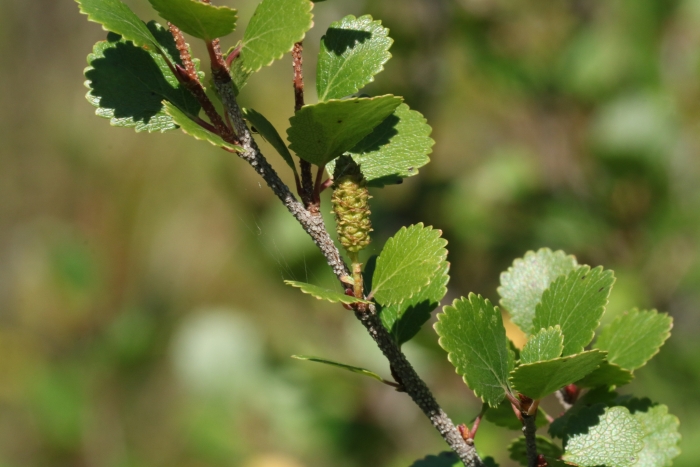American Dwarf Birch
(Betula glandulosa)
American Dwarf Birch (Betula glandulosa)
/
/

© Dustin Snider
CC BY 4.0
Image By:
© Dustin Snider
Recorded By:
Copyright:
CC BY 4.0
Copyright Notice:
Photo by: © Dustin Snider | License Type: CC BY 4.0 | License URL: http://creativecommons.org/licenses/by/4.0/ | Uploader: dustin777 | Publisher: iNaturalist |

























Estimated Native Range
Summary
Betula glandulosa, commonly known as American dwarf birch or resin birch, is a deciduous shrub native to the tundra and taiga regions, as well as boreal forests and subalpine zones across North America and Asia. It is typically found in Alaska, Newfoundland, Greenland, and extends south at high altitudes to northern California and Colorado. This species usually grows 3-10 feet tall and forms dense thickets with slender trunks. Its smooth dark brown bark and nearly circular to oval leaves with a toothed margin are characteristic. The leaves turn yellow in the fall, adding seasonal interest. The fruiting catkins are erect and small, and while not particularly showy, they are an important food source for wildlife.
American dwarf birch is valued for its adaptability to cold climates and wetland habitats like bogs and muskegs, where it plays a crucial role in soil stabilization and provides forage for moose, deer, and caribou. It is often used in reclamation projects and naturalistic plantings. In cultivation, it requires consistently moist soil conditions and can tolerate full sun to part shade. While generally low-maintenance, it can be susceptible to birch leafminer and bronze birch borer. Gardeners in cold regions appreciate this shrub for its hardiness and ecological benefits.CC BY-SA 4.0
American dwarf birch is valued for its adaptability to cold climates and wetland habitats like bogs and muskegs, where it plays a crucial role in soil stabilization and provides forage for moose, deer, and caribou. It is often used in reclamation projects and naturalistic plantings. In cultivation, it requires consistently moist soil conditions and can tolerate full sun to part shade. While generally low-maintenance, it can be susceptible to birch leafminer and bronze birch borer. Gardeners in cold regions appreciate this shrub for its hardiness and ecological benefits.CC BY-SA 4.0
Plant Description
- Plant Type: Shrub
- Height: 3-10 feet
- Width: 6-10 feet
- Growth Rate: Moderate
- Flower Color: N/A
- Flowering Season: Spring, Summer
- Leaf Retention: Deciduous
Growth Requirements
- Sun: Full Sun
- Water: Medium
- Drainage: Medium
Common Uses
Erosion Control, Low Maintenance, Water Garden
Natural Habitat
native to the tundra and taiga regions, as well as boreal forests and subalpine zones across North America and Asia
Other Names
Common Names: Glandular Birch, Resin Birch, Bog Birch, Glandular Shrub Birch, Scrub Birch, American Dwarf Birch, Tundra Dwarf Birch
Scientific Names: , Betula glandulosa, Betula abolinii, Betula exilis, Betula glandulosa f. typica, Betula glandulosa var. eucycla, Betula glandulosa var. flabellifolia, Betula glandulosa var. glandulosa, Betula glandulosa var. pseudoalpestris, Betula glandulosa var. pumila
GBIF Accepted Name: